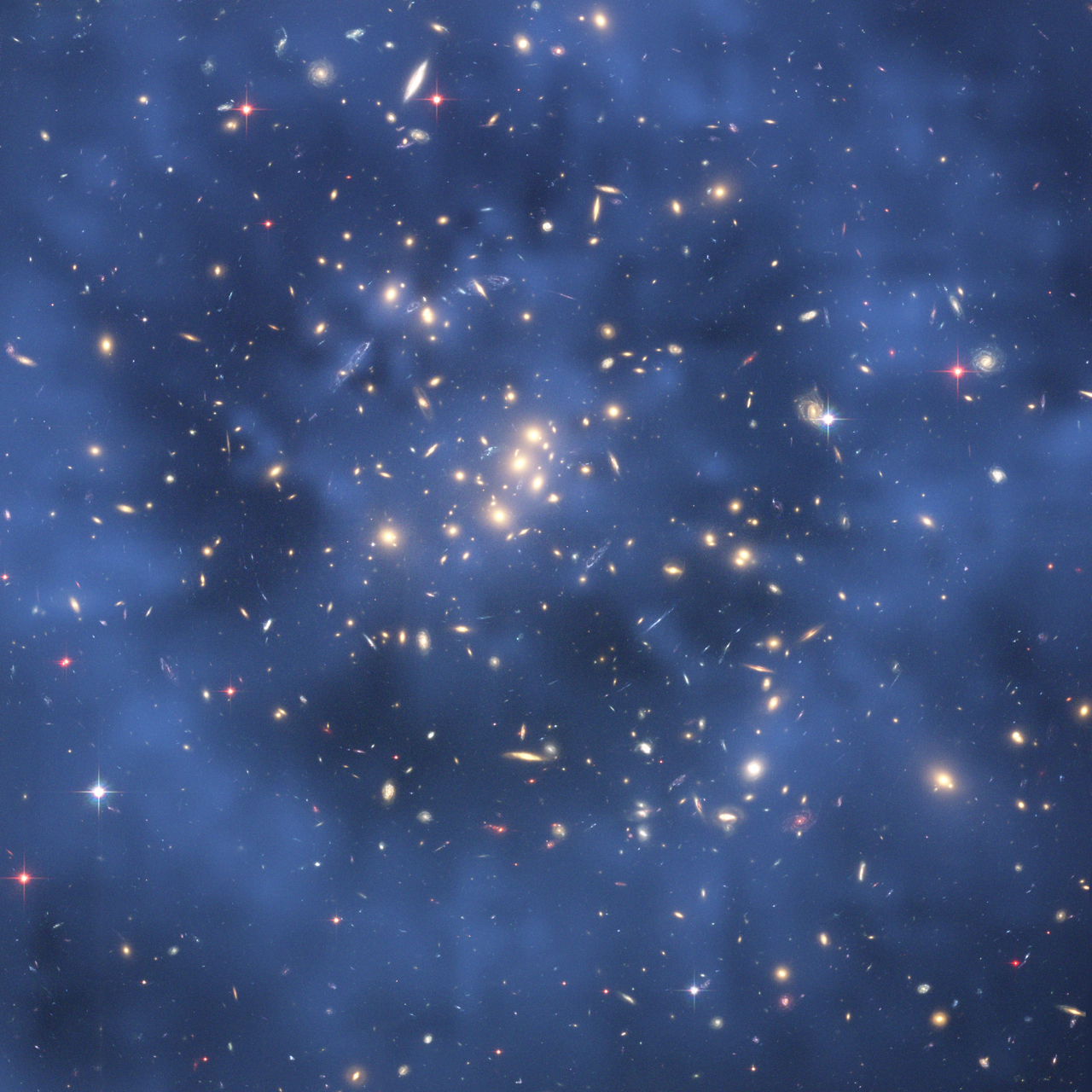New Dark Matter Theory Weighs Superheavy Particle

Dark matter could be made of particles that each weigh almost as much as a human cell and are nearly dense enough to become miniature black holes, new research suggests.
While dark matter is thought to make up five-sixths of all matter in the universe, scientists don't know what this strange stuff is made of. True to its name, dark matter is invisible — it does not emit, reflect or even block light. As a result, dark matter can currently be studied only through its gravitational effects on normal matter. The nature of dark matter is currently one of the greatest mysteries in science.
If dark matter is made of such superheavy particles, astronomers could detect evidence of them in the afterglow of the Big Bang, the authors of a new research study said. [Dark Matter Explained (Infographic)]

Previous dark matter research has mostly ruled out all known ordinary materials as candidates for what makes up this mysterious stuff. Gravitational effects attributed to dark matter include the orbital motions of galaxies: The combined mass of the visible matter in a galaxy, such as stars and gas clouds, cannot account for a galaxy's motion, so an additional, invisible mass must be present. The consensus so far among scientists is that this missing mass is made up of a new species of particles that interact only very weakly with ordinary matter. These new particles would exist outside the Standard Model of particle physics, which is the best current description of the subatomic world.
Some dark matter models suggest that this cosmic substance is made of weakly interacting massive particles, or WIMPs, that are thought to be about 100 times the mass of a proton, said study co-author McCullen Sandora, a cosmologist at the University of Southern Denmark. However, despite many searches, researchers have not conclusively detected any WIMPs so far, leaving open the possibility that dark matter particles could be made of something significantly different.
Now Sandora and his colleagues are exploring the upper mass limit of dark matter — that is, they're trying to discover just how massive these individual particles could possibly be, based on what scientists know about them. In this new model, known as Planckian interacting dark matter, each of the weakly interacting particles weighs about 1019 or 10 billion billion times more than a proton, or "about as heavy as a particle can be before it becomes a miniature black hole," Sandora told Space.com.
A particle that is 1019 the mass of a proton weighs about 1 microgram. In comparison, research suggests that a typical human cell weighs about 3.5 micrograms.
Breaking space news, the latest updates on rocket launches, skywatching events and more!
The genesis of the idea for these supermassive particles "began with a feeling of despondency that the ongoing efforts to produce or detect WIMPs don't seem to be yielding any promising clues," Sandora said. "We can't rule out the WIMP scenario yet, but with each passing year, it's getting more and more suspect that we haven't been able to achieve this yet. In fact, so far there have been no definitive hints that there is any new physics beyond the Standard Model at any accessible energy scales, so we were driven to think of the ultimate limit to this scenario."
But now the researchers have suggested that if these particles exist, signs of their existence might be detectable in the cosmic microwave background radiation, the afterglow of the Big Bang that created the universe about 13.8 billion years ago.
Currently, the prevailing view in cosmology is that moments after the Big Bang, the universe grew gigantically in size. This enormous growth spurt, called inflation, would have smoothed out the cosmos, explaining why it now looks mostly similar in every direction.
After inflation ended, research suggests that the leftover energy heated the newborn universe during an epoch called "reheating." Sandora and his colleagues suggest that extreme temperatures generated during reheating could have produced large amounts of their superheavy particles, enough to explain dark matter's current gravitational effects on the universe.
However, for this model to work, the heat during reheating would have had to be significantly higher than what is typically assumed in universal models. A hotter reheating would in turn leave a signature in the cosmic microwave background radiation that the next generation of cosmic microwave background experiments could detect. "All this will happen within the next few years hopefully, next decade, max," Sandora said.
If dark matter is made of these superheavy particles, such a discovery would not only shed light on the nature of most of the universe's matter, but also yield insights into the nature of inflation and how it started and stopped — all of which remains highly uncertain, the researchers said.
For example, if dark matter is made of these superheavy particles, that reveals "that inflation happened at a very high energy, which in turn means that it was able to produce not just fluctuations in the temperature of the early universe, but also in space-time itself, in the form of gravitational waves," Sandora said. "Second, it tells us that the energy of inflation had to decay into matter extremely rapidly, because if it had taken too long, the universe would have cooled to the point where it would not have been able to produce any Planckian interacting dark matter particles at all."
Sandora and his colleagues detailed their findings online March 10 in the journal Physical Review Letters.
Follow Charles Q. Choi on Twitter @cqchoi. Follow us @Spacedotcom, Facebook and Google+. Original article on Space.com.
Join our Space Forums to keep talking space on the latest missions, night sky and more! And if you have a news tip, correction or comment, let us know at: community@space.com.

Charles Q. Choi is a contributing writer for Space.com and Live Science. He covers all things human origins and astronomy as well as physics, animals and general science topics. Charles has a Master of Arts degree from the University of Missouri-Columbia, School of Journalism and a Bachelor of Arts degree from the University of South Florida. Charles has visited every continent on Earth, drinking rancid yak butter tea in Lhasa, snorkeling with sea lions in the Galapagos and even climbing an iceberg in Antarctica. Visit him at http://www.sciwriter.us
